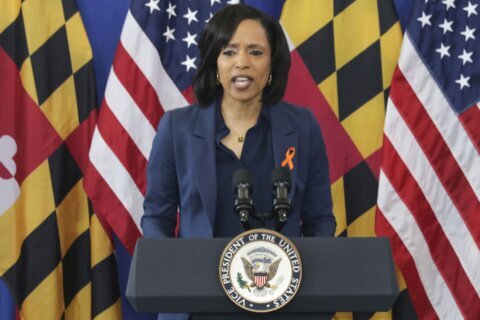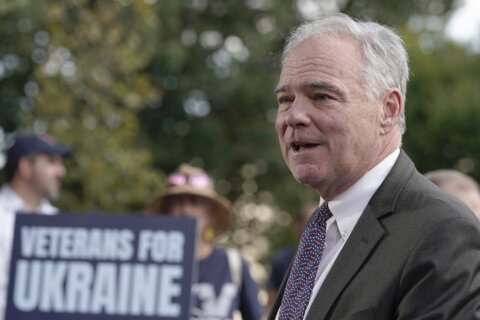Election officials in Maryland — including in some of the state’s largest counties, such as Montgomery and Prince George’s — are still making their way through a mountain of mail-in ballots.
Overall, as of Friday morning, there were still more than 608,000 mail-in ballots across the state that had yet to be counted. That equates to about 40% of the total number of mail-in ballots so far received by local election boards.
In Montgomery County, only about half of all mail-in ballots — about 178,000 ballots — had actually been counted as of Thursday. There were still more than 165,000 mail-in ballots that had yet to be counted in Montgomery County, according to state elections data.
In Prince George’s County, where voters submitted about 237,000 mail-in ballots, about a quarter of them — more than 58,000 — have yet to be counted.
- Presidential Elections Map
- Maryland Election Results
- Maryland’s County-By-County Results
- Virginia Election Results
- Virginia’s County-By-County Results
- DC Election Results
The Associated Press called all eight congressional races in Maryland, as well as the two statewide ballot questions legalizing sports betting and giving state lawmakers more power over the state’s budget.
However, local races, including local ballot questions and school board races, remain officially uncalled.
Here’s a look at the status of the vote count, and where issues and candidates stand, as of Thursday night.
Montgomery County
The state’s most populous county, where there are nearly 675,000 registered voters, a total of 347,616 votes have been counted as of Thursday night. That includes ballots cast on Election Day, during early voting and mail-in ballots received by the board of elections by Oct. 21.
Mail-in ballots submitted after Oct. 21 started being tabulated during the canvassing process Thursday but have not yet been publicly reported.
Even though the votes are still being counted, several groups advocating for local ballot measures that would add two seats to the county council and overhaul the county’s property tax formula have declared victory.
A news release from the groups — including “Montgomery Neighbors Against Question B” and “Residents for More Representation” — said the groups were celebrating “success at the ballot box.”
The news release stated: “With a shared vision of a better Montgomery County that works for everyone, we successfully took our message to voters about the County ballot questions … Whether it is tax policy or representation, the politics of lifting people up is more powerful than tearing people down. When we believe changes are needed, we are capable of coming together as a community to make it happen.”
Question A, which was supported by county leaders and a broad coalition of progressive organizations, does away with an existing cap on the overall amount of property tax revenue the county can collect in favor of an annual cap on property tax rates that backers say would allow the county to take advantage of a growing tax base. Raising the property tax rate would require a unanimous vote by the council.
According to the vote totals available Friday morning, support for Question A was running at 61.1%. The measure needed 50% to pass.
Question B, a competing measure spearheaded by attorney and activist Robin Ficker, would have kept the current cap on tax revenue collection in place and prohibited a unanimous council vote from raising collections beyond that. It was trailing in the vote totals available; support for Question B was running at 43%.
Similarly, Question C, a proposal supported by most of Montgomery County’s political establishment that would add two district seats to the county council, was leading in vote totals counted so far, with 61.1% of the vote.
Support for competing Question D, which would have done away with the council’s four at-large seats in favor of a council made up entirely of district seats, was trailing, at 43%.
In the race for three Board of Education of seats, two incumbent board members held strong leads against challengers.
In District 2, Rebecca Smondrowski, who was first elected to her seat in 2016, held a lead over challenger Michael Fryar, 59.4% to 39.8%.
In District 4, board President Shebra Evans fended off a challenge from talk radio host Steve Solomon, with more than 64% of the vote compared to about 35% for Solomon. On Twitter, Evans, who was first elected to the board in 2016, declared victory.
I want to express my heartfelt thanks to everyone that cast their vote in support of my reelection to the Montgomery County Board of Education. Truly honored that you have put your trust in me. Looking forward to continuing the work.
— Shebra Evans (@ShebraEvans) November 4, 2020
In the at-large board of education seat, which was open because of a retirement, Lynne Harris led, with 53.5% of the vote compared to 45.3% for opponent Sunil Dasgupta. Dasgupta, a political science professor, conceded the race to Harris, a Silver Spring teacher, on Twitter.
My congratulations to Lynne Harris, our next At-Large BOE member. The BOE is getting an experienced, fierce advocate who will center student voices & help lead us through this difficult time. I look fwd to working w Lynne to support students, staff & families. So much to be done! pic.twitter.com/IGJIl2HGon
— Sunil Dasgupta (he/him) (@sunildasgupta4) November 4, 2020
Prince George’s County
With 604,369 registered voters, a total of 357,761 votes had been counted as of Thursday night. That includes about 180,000 mail-in ballots that have been counted so far. But another 58,265 mail-in ballots have yet to be counted, according to the state board of elections.
Still, based on the votes counted so far, voters were poised to approve five bond issues on the ballot — allowing the county to borrow more than half a billion dollars to fund capital projects.
It has been decades since Prince George’s County voters have rejected a bond issue.
Based on the vote totals so far:
- Support for Question A, a $178.15 million bond issue for public works and transportation projects, was 87.9%.
- Support for Question B, a nearly $28.83 million bond issue for library facilities, was 86.6%.
- Support for Question C, a nearly $44.48 million bond issue for public safety facilities, was 87%.
- Support for Question D, a $133 million bond issue for county buildings, was 77.6%.
- Support for Question E, a $121.7 million bond issue for community college facilities, was 88.5%.
Here’s where things stand in Prince George’s County school board races, where there were three contested races on the ballot.
In the District 4 race, Bryan Swann, who has held the seat since being appointed in January to fill a vacancy, was trailing challenger Shayla Adams-Stafford in vote totals so far. Adams-Stafford held a 65.9% to 33.7% lead over Swann, who was endorsed by County Executive Angela Alsobrooks.
Adams-Stafford, an advocate of project-based learning, who was endorsed by the Prince George’s County Educators’ Association, declared victory on Twitter.
THANK YOU to all who supported my campaign for Prince George’s County Board of Education! I hope you will continue to join me in this fight for the future of our students when I join the Board this December! pic.twitter.com/AkXxubSymf
— Shayla Adams-Stafford (@stafford_shayla) November 6, 2020
In District 7, Kenneth F. Harris, a STEM advocate and NASA engineer, held a big lead over Alexis Nicole Branch — 64.5% to 35.2%. Harris was also endorsed by the Prince George’s County Educators’ Association.
In District 8, Edward Burroughs III, the board’s longest-serving member at age 28, also held a commanding lead over challenger Gary Lee Falls — 86% to 13.2%. Burroughs first served as a student member on the board and has been reelected as an adult three previous times.
Incumbent school Board members David H. Murray, in District 1, and Raaheela Ahmed, in District 5, ran unopposed.








